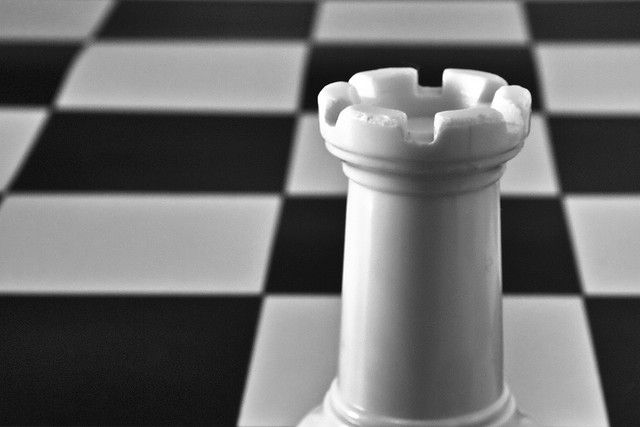
What's Your Favorite Chess Piece?
Before we even play our first game of chess, we learn how the pieces move. The fact that the pieces travel the board in different ways is our first clue that the pieces themselves are not interchangeable.
After a while, we find out about the “point values” of the pieces. These values are based on mobility, not power, since every piece can only control a square once. It’s the number of squares a piece can move to that determines its point value.
Queens, we’re told, are worth nine points. Rooks are five points. Bishops and knights are about three points each. Pawns are the baseline, worth one point.
Kings are assigned a value of infinity, of course, because their loss loses the game. In the endgame, kings are said to have a “fighting value” of about four points.
Just as we memorize these point values, we learn about the quality of pieces. A well-posted knight on the sixth rank can be worth much more than a rook on the first. A pawn on the seventh rank could be worth as much as a queen. A bishop with free rein on a long diagonal is exponentially more valuable than one hemmed in by its own pawns.
As chess players, it’s our job to incorporate quality, mobility, and point value when we evaluate material.
But none of the above answers the question of which chess piece is your favorite? Which piece is the most fun?
The rankings below, of course, are subjective and are written from the viewpoints of beginning and intermediate players.
Every chess player is going to have his favorite and least favorite pieces. Let us know the pieces you love and hate in the comments and on Facebook.
6. Bishop

Bobby Fischer loved attacking as White with his light-squared bishop. Many beautiful combinations have either been initiated by bishop sacrifices or finished off with bishop mates. No competent chess player will dispute the awesome power of the bishop pair.
Chess.com’s FM Mike Klein even made a video series about stunning bishop moves that you absolutely should watch before judging this piece.
Despite all these good things, the fact remains that the bishop is the only piece restricted to a single color, and can move to just half the squares on the board.
5. Knight

The stronger a chess player you are, the more you appreciate the knight. The knight is perhaps the most aptly named chess piece, as it’s perfectly suited for brutal close combat.
Unlike the long-range bishop or the heavy artillery of the queen and rook, the knight is not afraid to get up-close-and-personal in doing its job. The knight pairs particularly well with the queen, working together to control almost every important square in the attack.
But it’s not all accolades for the knight, either. Almost as soon as beginning players learn to stop calling their knights “horses,” they find themselves getting forked and mated by the tricky piece when employed by more experienced players.
Even for the strongest players, the knight is not the best piece, as illustrated by GM Dejan Bojkov’s video series on the weaknesses of the knight.
4. King

It’s a little silly even ranking the king, of course, since it’s the most important piece and you have to be serious about keeping it safe. But can you have fun using a king?
Sure you can. While kings must often stay hidden away in the opening and middlegame, in the endgame they can become juggernaut attacking pieces.
Rarely, you can have fun with a king much earlier in the game. You haven’t lived as a chess player until you’ve castled for checkmate.
3. Pawn

Maybe you’re surprised to see the lowly pawn ranked so well on this list. But no less an authority than Francois Philidor said “pawns are the soul of chess.”
Pawns have lots of unique powers that make them fun to play with. They are the only piece that captures differently from how they move. Pawns also cannot go backward, which makes them fun to charge forward.
Finally, pawns can “score a touchdown” by reaching the eighth rank and promoting into a queen — or even more fun — underpromoting.
2. Queen

There’s no disputing that the queen is the most mobile and therefore most powerful piece on the board. Combining the movements of the bishop and the rook, the queen can reach almost any square on the board very quickly, often by multiple routes.
Beginners love using their queens — often too much — bringing them out too early, and making them vulnerable to attack.
Once players begin to realize how careful they must protect their queens, almost like a second king, much of the fun is taken out of using the piece. GM Mikhail Tal clearly did not have this problem, as he loved sacrificing his queen to achieve checkmate or otherwise winning positions.
1. Rook

The rook is my favorite chess piece, and I suspect many players agree with me. The rook has a simple, almost minimalist movement: as far as it wants, in a straight line.
Rooks are the most difficult piece to develop in the opening, but nothing beats the satisfaction of completing your development by finally castling, connecting rooks, and moving them to their ideal files.
In the middlegame, rooks are continually threatening to blast open the castled king’s position, sacrifice themselves for a bishop or knight, or support the queen or another rook in a deadly battery.
It’s in the endgame, though, where rooks really rule. Often the only survivors left with a few straggling pawns and the kings, rooks control huge swaths of the board, swinging the game’s result at their whim.
Which piece do you think is the most fun? Let us know your favorites in the comments.
GET THE MOST OUT OF CHESS.COM
- Read Pete's previous article, The 11 Worst Chessboard Photos.
- Watch IM Daniel Rensch play hilarious giant bullet chess with strong grandmasters!
- Check out some of our fun video lectures: IM Rensch and GM Finegold are two of our most popular authors.
- Have fun and learn at the same time with the Tactics Trainer.
- Looking for articles with deeper analysis? Try our magazine: The Master's Bulletin.

